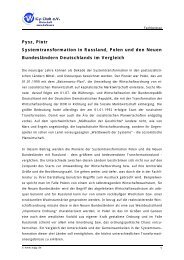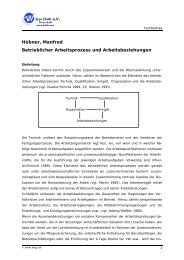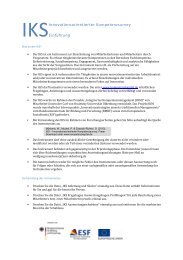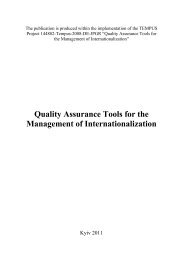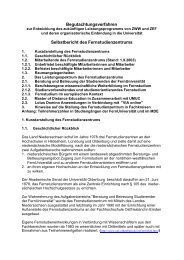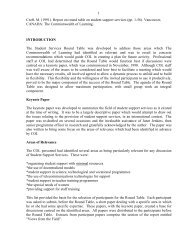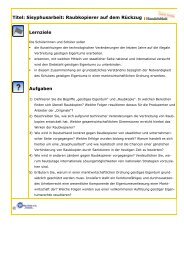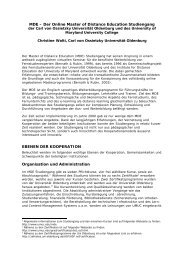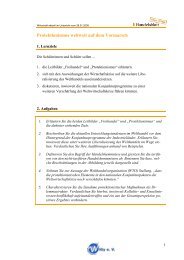Assessing the Costs and Benefits of Telelearning: A Case Study ...
Assessing the Costs and Benefits of Telelearning: A Case Study ...
Assessing the Costs and Benefits of Telelearning: A Case Study ...
You also want an ePaper? Increase the reach of your titles
YUMPU automatically turns print PDFs into web optimized ePapers that Google loves.
Ano<strong>the</strong>r transition seems to be occurring in research papers associated with<br />
CSILE. Questions about concepts <strong>of</strong> "cognition" have surfaced. Changing ideas related<br />
to those questions are influencing <strong>the</strong> articulated pedagogy associated with CSILE<br />
research development. Earlier papers were concerned with "intentional learning"<br />
described as "cognitive processes that have learning as a goal ra<strong>the</strong>r than an incidental<br />
outcome (Bereiter <strong>and</strong> Scardamalia, (1989), p. 363, Intentional Learning As A Goal <strong>of</strong><br />
Instruction, in Knowledge, Learning <strong>and</strong> Instruction.)<br />
One <strong>of</strong> <strong>the</strong> most recent papers, Design Principles for <strong>the</strong> Support <strong>of</strong> Distributed<br />
Processes, by Jim Hewitt <strong>and</strong> Marlene Scardamalia refer to "cognition as distributed over<br />
both individuals <strong>and</strong> <strong>the</strong>ir surroundings" (p.1). Those holding a "distributed cognition<br />
perspective" believe that cognition is fundamentally distributed, "<strong>the</strong> tools, rules, values<br />
<strong>and</strong> actors in a classroom constitute a highly complex, interacting system". This<br />
conception forms <strong>the</strong> basis for asking pragmatic questions about "what kinds <strong>of</strong><br />
distributions are educationally effective?"<br />
A recent paper, Situative Design Issues for Interactive Learning Environments:<br />
The Problem <strong>of</strong> Group Coherence, by Jim Hewitt <strong>and</strong> Marlene Scardamalia, refers to<br />
"situative perspective". Those who espouse this <strong>the</strong>ory believe that "<strong>the</strong> relationship<br />
between mind <strong>and</strong> environment is so complex <strong>and</strong> so interdependent, that it is an<br />
oversimplification to consider <strong>the</strong>m separately" (p. 2). According to <strong>the</strong> authors,<br />
cognitivist <strong>the</strong>ory tends to consider cases one at a time. Eschewing <strong>the</strong> mind-world<br />
dualism <strong>of</strong> cognitivists, a situative perspective brings new meaning to <strong>the</strong> concept <strong>of</strong><br />
"knowing something" — "it is no longer a matter <strong>of</strong> storing ideas in your head that can be<br />
applied to different situations. Ra<strong>the</strong>r, 'knowing' is tied to context, distributed across <strong>the</strong><br />
individual, situational affordances <strong>and</strong> o<strong>the</strong>r people. Similarly 'learning' 's not <strong>the</strong><br />
personal acquisition <strong>of</strong> knowledge, but is instead understood as participation in an active<br />
system." (Paraphrased from, Situative Design Issues for Interactive Learning<br />
Environments: The Problem <strong>of</strong> Group Coherence, by Hewitt <strong>and</strong> Scardamalia, p.3.)<br />
For this holistic view to researching, <strong>the</strong> paper describes a model by Engestrom<br />
(1990) in Learning, Working <strong>and</strong> Imagining. He: "views human activity as an<br />
interdependent system involving <strong>the</strong> individual (or subject), tools, a problem space (or<br />
object), <strong>the</strong> community <strong>of</strong> people who are similarly concerned with <strong>the</strong> problem, <strong>the</strong><br />
division <strong>of</strong> labor between community members, <strong>and</strong> <strong>the</strong> conventions (rules) regarding<br />
actions. (Paraphrased from, Situative Design Issues for Interactive Learning<br />
Environments: The Problem <strong>of</strong> Group Coherence, Hewitt <strong>and</strong> Scardamalia, p.4.)<br />
Ascribed <strong>Benefits</strong>. Claims are made by CSILE developers <strong>and</strong> researchers that it<br />
provides a crucible for creating a Knowledge-Building Community through several<br />
means:<br />
• Student’s Ideas as Objects <strong>of</strong> Inquiry: Student-created knowledge artifacts are<br />
available to <strong>the</strong> entire community <strong>and</strong> serve as a foundation for creating o<strong>the</strong>r more<br />
advanced artifacts.<br />
• Knowledge <strong>of</strong> <strong>the</strong> Collective as Primary: The goal is to continually extend <strong>the</strong><br />
knowledge <strong>of</strong> <strong>the</strong> collective. Individual underst<strong>and</strong>ing is driven forward by <strong>the</strong> dual<br />
need to be familiar with <strong>the</strong> knowledge <strong>of</strong> <strong>the</strong> collective, <strong>and</strong> <strong>the</strong> desire to advance<br />
that knowledge.<br />
• Responsibility Transferred to Students: Each student shares some responsibility for<br />
planning, organization, posing question <strong>and</strong> summarizing.<br />
61



